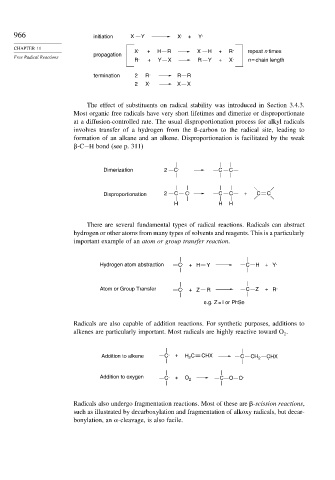Page 982 - Advanced Organic Chemistry Part A - Structure and Mechanisms, 5th ed (2007) - Carey _ Sundberg
P. 982
966 initiation X Y X . + Y .
CHAPTER 11 . .
X + H R X H + R repeat n times
propagation
Free Radical Reactions . .
R + Y X R Y + X n = chain length
termination 2 R . R R
2 X . X X
The effect of substituents on radical stability was introduced in Section 3.4.3.
Most organic free radicals have very short lifetimes and dimerize or disproportionate
at a diffusion-controlled rate. The usual disproportionation process for alkyl radicals
involves transfer of a hydrogen from the ß-carbon to the radical site, leading to
formation of an alkane and an alkene. Disproportionation is facilitated by the weak
-C−H bond (see p. 311)
Dimerization 2 C . C C
Disproportionation 2 C C . C C + C C
H H H
There are several fundamental types of radical reactions. Radicals can abstract
hydrogen or other atoms from many types of solvents and reagents. This is a particularly
important example of an atom or group transfer reaction.
Hydrogen atom abstraction C . + H Y C H + Y .
Atom or Group Transfer C . + Z R C Z + R .
e.g. Z = I or PhSe
Radicals are also capable of addition reactions. For synthetic purposes, additions to
alkenes are particularly important. Most radicals are highly reactive toward O .
2
Addition to alkene C . + H 2 C CHX C CH 2 CHX
.
Addition to oxygen C . + O 2 C O O .
Radicals also undergo fragmentation reactions. Most of these are -scission reactions,
such as illustrated by decarboxylation and fragmentation of alkoxy radicals, but decar-
bonylation, an -cleavage, is also facile.

